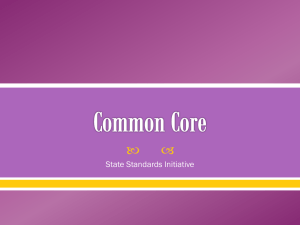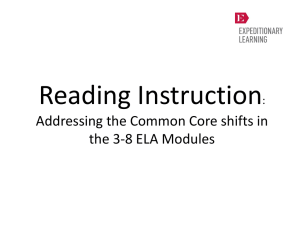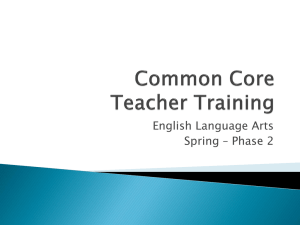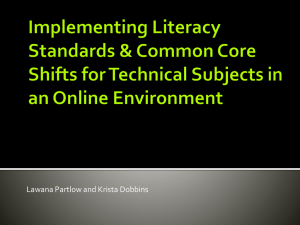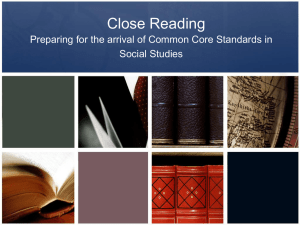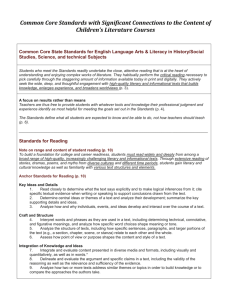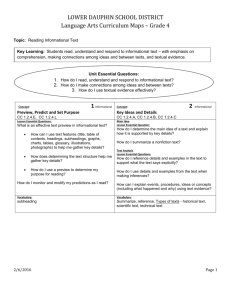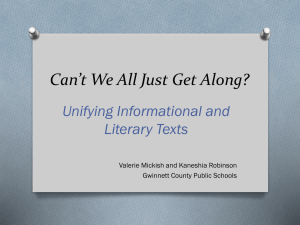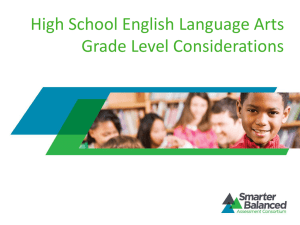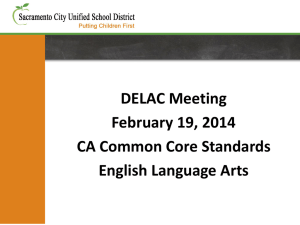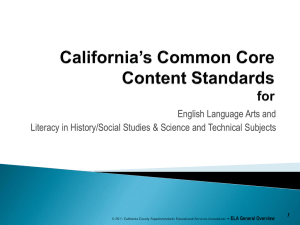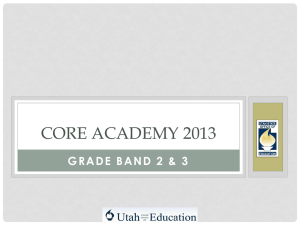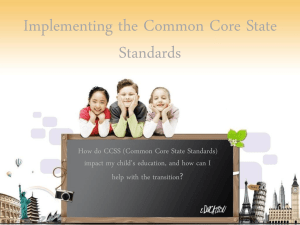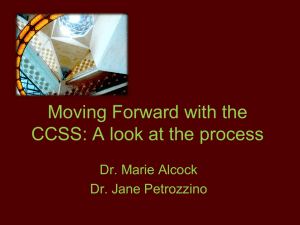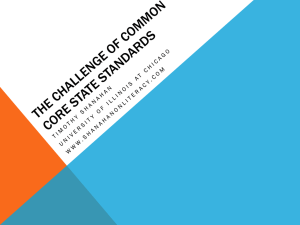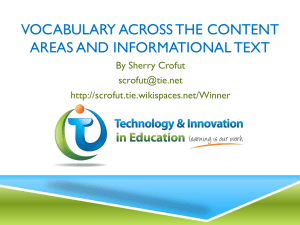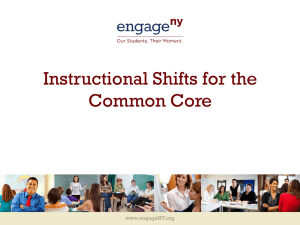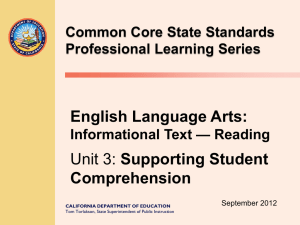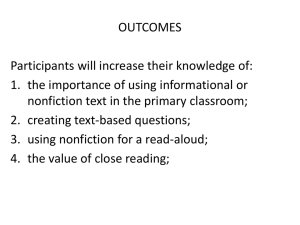Common Core
advertisement
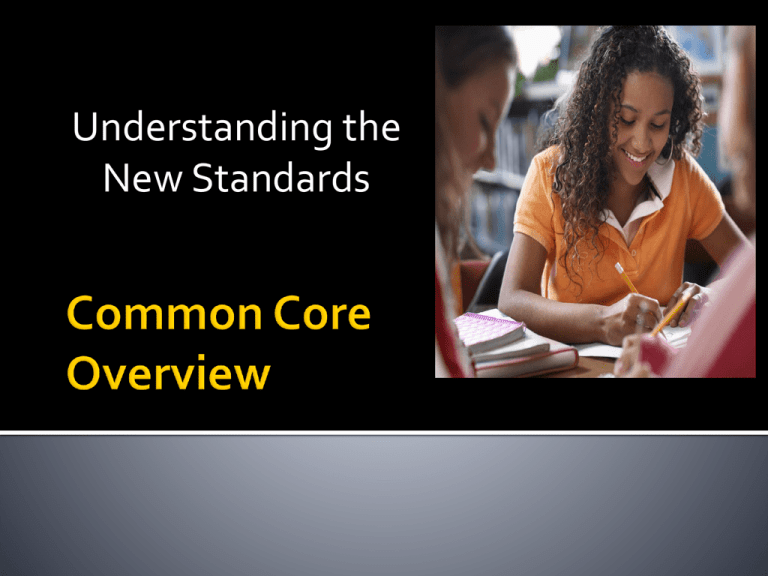
Understanding the New Standards Learning Objectives will answer these Essential Questions: What are Common Core Standards? Why is Common Core necessary? What do these standards mean in the context of my school, my classroom, my students? What is “text complexity,” and how can I implement it in my teaching? What are text-dependent questions? Why is it necessary? WHY??? “A large gap still exists between how high school teachers perceive the college readiness of high school graduates and how college instructors perceive the readiness of their incoming first-year students. This suggests a lack of curricular alignment between the K-12 and postsecondary educations systems that may be hampering the efforts of K12 to prepare students for life after high school.” Policy Implications for Preparing for Higher Standards (ACT National Curriculum Survey 2012) How did it all begin? Previous state standards did not improve student achievement. Gaps in achievement Gaps in expectations NAEP results ACT 2012 data – College Readiness Benchmark All 4 subject areas: 3 subject areas: 2 subject areas: 1 subject area: None 25% 15% 17% 15% 28% College remediation rates 7 Beginning in the spring of 2009, Governors and state commissioners of education from 48 states, 2 territories and the District of Columbia committed to developing a common core of state K-12 English-language arts (ELA) and mathematics standards. The Common Core State Standards Initiative (CCSSI) is a state-led effort coordinated by the National Governors Association (NGA) and the Council of Chief State School Officers (CCSSO). www.corestandards.org Standards: A clear set of shared goals and expectations Narrowed focus Strong emphasis on foundational basics Text complexity Skill reinforcement Common Core will focus more on process with less emphasis on rote memorization. Deeper knowledge is required for students to be properly equipped for the technologically-advanced jobs of the future. Teachers will cover fewer standards more thoroughly. Domain Cluster Standard 12 Define what students should understand and be able to do. A big idea that bridges across grade levels. Domain: Operations & Algebraic Thinking (OA) 14 Groups of related standards The Math standards stress not only procedural skill but also conceptual understanding, to make sure students are learning and absorbing the critical information they need to succeed at higher levels ‐ rather than the current practices by which many students learn enough to get by on the next test, but forget it shortly thereafter, only to review again the following year. Having built a strong foundation K‐5, students can do hands on learning in geometry, algebra and probability and statistics. Students who have completed 7th grade and mastered the content and skills through the 7th grade will be well‐ prepared for algebra in grade 8. The high school Math standards call on students to practice applying mathematical ways of thinking to real world issues and challenges; they prepare students to think and reason mathematically. The high school standards set a rigorous definition of college and career readiness, by helping students develop a depth of understanding and ability to apply mathematics to novel situations, as college students and employees regularly do. The high school standards emphasize mathematical modeling, the use of mathematics and statistics to analyze empirical situations, understand them better, and improve decisions. The ELA standards establish a “staircase” of increasing complexity in what students must be able to read so all are ready for the demands of college‐ and career‐level reading. The standards require the progressive development of reading comprehension so that students advancing through the grades gain more from whatever they read. Through reading a diverse array of classic and contemporary literature (classic myths, American literature, and Shakespeare) as well as challenging informational texts in a range of subjects (foundational U.S. documents), students build knowledge, gain insights, explore possibilities, and broaden their perspective. The standards are building blocks for successful classrooms. Reading Language Literary Standards Speaking & Listening Writing 1. Building knowledge through contentrich nonfiction 2. Reading, writing and speaking grounded in evidence from text, both literary and informational 3. Regular practice with complex text and its academic language The 1st Major Shift in CC Build knowledge using informational text 50/50 narrative/informational elementary 45/55 narrative/informational middle grades 25/75 narrative /informational high school • Students are required to read very little informational text in elementary and middle school. • Non-fiction makes up the vast majority of required reading in college/workplace. • Informational text is harder for students to comprehend than narrative text. • Supports students learning how to read different types of informational text. Literary Text • Fiction Informational Text • Exposition • Literary nonfiction, such as essays, speeches, and autobiographies or biographies • Argumentation and persuasive text • Procedural text and documents • Poetry Source: Reading Framework for the 2011 National Assessment of Educational Progress, September 2010 The 2nd Major Shift in CC Reading, writing, and speaking grounded in evidence from text, both literary and informational Asking students to make connections to themselves, other texts, and the world guides them away from the text and does not lead to a deep understanding of it. Students expend excessive time and energy answering low-level questions rather than meaningful, text-specific questions that will incite a deeper understanding. are only answered correctly with careful attention to the text. extend beyond recalling facts. often require inference. require no outside sources. allow students to gather evidence and build knowledge. provide access to increasing levels of complex text. necessitate thoughtful teacher preparation. require time for students to process. are meaningful. Not Text-Dependent In “Casey at the Bat,” Casey strikes out. Describe a time when you failed at something. In “Letter from a Birmingham Jail,” Dr. King discusses nonviolent protest. Discuss, in writing, a time when you wanted to fight against something that you felt was unfair. Text-Dependent What makes Casey’s experiences at bat humorous? Find examples from the text to support your answer. What can you infer from King’s letter about the letter that he received? 28 Content Shift #2 Which question is text-dependent? In “The Gettysburg Address, “Lincoln states that the nation is dedicated to the proposition that all men are created equal. Why is equality an important value to promote? or “The Gettysburg Address” mentions the year 1776. According to Lincoln’s speech, why is this year significant to the events described in the speech? The rd 3 major shift in CC Regular practice with complex text and its academic language What is “text complexity”? and Why is text complexity important? Text Complexity IS a concentrated effort to expose our students to more difficult texts. Transport them to realms outside of their comfort zones. Expose them to a vast assortment of genres, prompting them to become “literary entrepreneurs” who are willing to take risks. “Complex text is typified by a combination of longer sentences, a higher proportion of less-frequent words, and a greater number and variety of words with multiple meanings.” PARCC Model Content Frameworks Why is Text Complexity important? “The Common Core Standards hinge on students encountering appropriately complex texts at each grade level in order to develop the mature language skills and the conceptual knowledge they need for success in school and life” (p. 3). 1. Quantitative measures – readability and other scores of text complexity often best measured by computer software. 2. Qualitative measures – levels of meaning, structure, language conventionality and clarity, and knowledge demands often best measured by an attentive human reader. 3. Reader and Task considerations – background knowledge of reader, motivation, interests, and complexity generated by tasks assigned often best made by educators employing their professional judgment. Reader and Task AGAIN….... Why is it important? “A large gap still exists between how high school teachers perceive the college readiness of high school graduates and how college instructors perceive the readiness of their incoming first-year students. This suggests a lack of curricular alignment between the K-12 and postsecondary educations systems that may be hampering the efforts of K12 to prepare students for life after high school.” Policy Implications on Preparing for Higher Standards (ACT National Curriculum Survey 2012) introducing background knowledge immersing students in more complex language exposure and usage that makes a difference in their ability to access knowledge engaging students with carefully selected or constructed graphic organizers that make the structure of the text visible modeling how to interpret the meaning of texts that use more complex approaches, like satire or rhetorical argument engaging pairs or teams of students with more challenging texts as “buddies” and giving them opportunities to reflect on those texts through discussions with each other or through “buddy” journals making 20 percent of their class reading “stretch” texts that help them reach beyond their reading level 37 Thinking Maps For defining in context An Overview of all 8 Thinking Maps The Circle Map Defining in Context While at your desk, you should sit with your spine straight. The Backbone; Spinal Column The spines of A pointed, hard the cactus really hurt me. growth on a The hinged SPINE back of a book plant, as a thorn A pointed, hard growth of an animal; as a porcupine’s quill Evaluating Sources A student uses a circle map to display knowledge of the Renaissance. For describing things Bubble Map Accommodations bright round is is The sun is yellow is hot The sun is bright. The sun is hot. For comparing & contrasting Mice Step daughter goose Step Daughter Younger Mean Step sisters Step Daughters Older Cinderella Fairy God Mother Prince has party Mei Ping and The Silver Shoe Lost shoe Magic Wand Prince Went house to house Old lady Magic Goose Feathers Married prince Shoe In hut By Marisa For classifying things For seeing events in sequence For understanding cause & effect For seeing parts of a whole “Teaching word parts enhances a student’s understanding of terms.” Robert Marzano, Classroom Instruction That Works for seeing analogies Tom went to the store and bought lunch. jogged went Hardees the store hotdog and French fries lunch Relation Factor: is more precise than… Tom jogged to Hardees and bought a hotdog and french fries. CASINO : GAMBLER A) TROPHY : UMPIRE B) BUNGALOW : VOYAGER C) SCHOOL : TRUANT D) DEFEAT : COMPETITOR E) GYMNASIUM : ATHLETE as DIRGE : LAMENTATION A) LYRIC : MEDLEY B) EPIC : HISTORY C) MYTH : HEROISM D) ANTHEM : PRAISE E) ROMANCE : REALISM as BANISH : OUTCAST A) CAPTURE : PRISONER B) DESTROY : ENEMY C) DISCOVER : SNIPER D) ACCUSE : CRIMINAL E) DEFEND : VICTIM as “Creating a new theory is not like destroying an old barn and erecting a skyscraper in its place. It is rather like climbing a mountain, gaining new and wider views, discovering unexpected connections between our starting points and its rich environment. But the point from which we started out still exists and…forms a tiny part of our broad view gained by the mastery of the obstacles on our adventurous way up.” Albert Einstein Official Common Core website: http://www.corestandards.org Resources for All Domains http://commoncoreconversation.com http://achievethecore.org http://www.khanacademy.org/ www.kids.gov www.teachingchannel.org http://www.neok12.com/ http://www.flocabulary.com/ http://americanrhetoric.com

